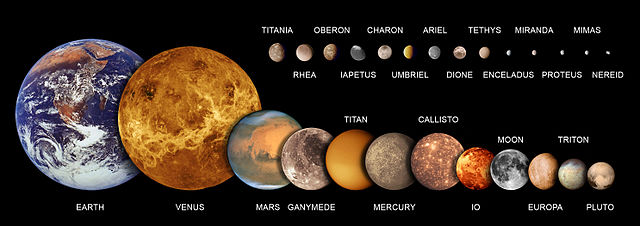A dwarf planet is a small planetary-mass object that is in direct orbit around the Sun, massive enough to be gravitationally rounded, but insufficient to achieve orbital dominance like the eight classical planets of the Solar System. The prototypical dwarf planet is Pluto, which for decades was regarded as a planet before the "dwarf" concept was adopted in 2006.
Ceres (1801)
Pluto (1930)
Quaoar (2002)
Sedna (2003)
A planetary-mass object (PMO), planemo, or planetary body is, by geophysical definition of celestial objects, any celestial object massive enough to achieve hydrostatic equilibrium, but not enough to sustain core fusion like a star.
The planetary-mass moons to scale, compared with Mercury, Venus, Earth, Mars, and Pluto (the other planetary-mass objects beyond Neptune have never been imaged up close). Borderline Proteus and Nereid (about the same size as round Mimas) have been included. Unimaged Dysnomia (intermediate in size between Tethys and Enceladus) is not shown; it is in any case probably not a solid body.
Planetary-mass satellites larger than Pluto, the largest Solar dwarf planet.
The dwarf planet Pluto
Artist's impression of a super-Jupiter around the brown dwarf 2M1207.







